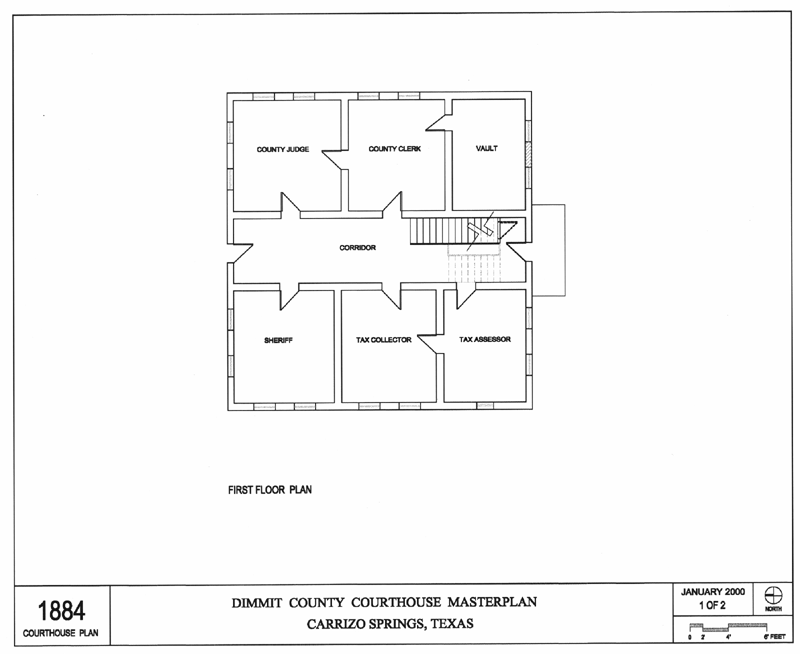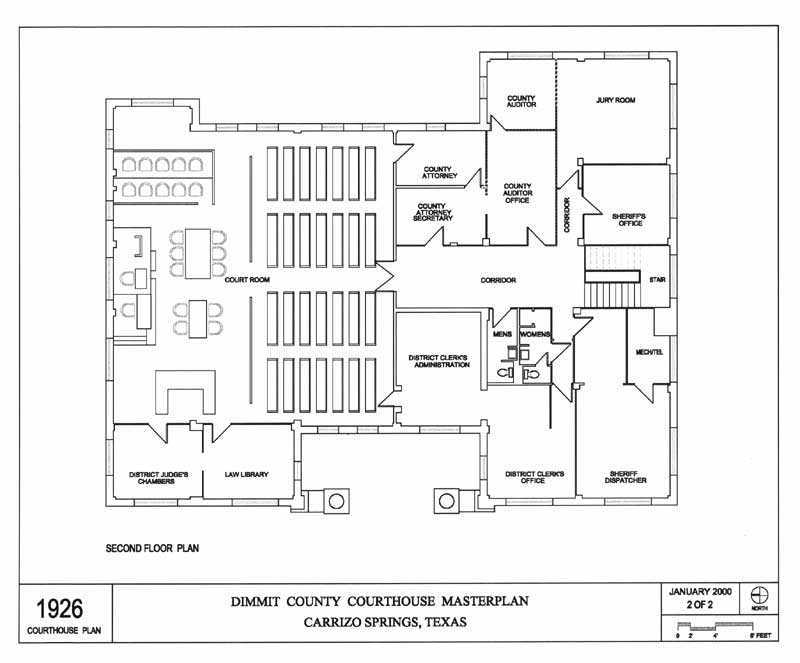
[Master Plan] [Introduction] [Development] [Timeline] Existing Conditions [Recommendations] [Bibliography]
| Master Plan For | |||
| The Restoration Of | |||
| The Dimmit County Courthouse | |||
The Dimmit County Courthouse was originally designed by noted architect Alfred Giles and constructed by J.C. Breeding and Sons in 1884. This simple two story, cube shaped Italianate building faced south from the center of the courthouse square. Each facade was composed of five bays framed by stone faced pilasters at each corner. The wooden, double hung windows were capped by stone lintels on the ground floor and segmental arches on the upper floor. The hipped roof featured a cast iron roof cresting and two interior chimneys. The entrance featured an Italianate style double gallery wood porch with a hipped roof. The first floor of the 1884 building housed county departments (see 1884 courthouse plan, sheet 1 of 2, page 41) and the second floor housed the district courtroom and district clerk’s office (see 1884 courthouse plan, sheet 2 of 2, page 42).
A major remodeling of the courthouse occurred in 1926 under the direction of San Antonio architect Henry T. Phelps. This historic enlargement of the building increased the size of the courthouse from 4,756 square feet to 8,812 square feet (see 1926 courthouse plan, sheets 1-2, pages 43-44). Rather than demolish the existing 1884 building, the new design significantly enlarged the building to the north and south. The design displays the characteristic features of the Classical Revival style, including an entry framed by monumental Ionic columns, a well defined entablature with the county’s name carved beneath scrollwork, and rusticated stone masonry (see elevations for existing conditions following page 75). Whereas the Giles design faced south, the 1926 design changed the main entry to face to the west on 5th Street, toward a new highway which ran through town. Secondary entrances are located on the north and south elevations. The main entrance opens onto a small foyer with the main axis of the interior corridor retaining the north-south axis of the original building.
The courthouse building is a two story, concrete framed building. Exterior walls are cut stone infilled between the concrete framing members with finish cut limestone (ashlar blocks) covering the exterior. There are two small basements at the south end, one located at the south central portion and the other at the southwest corner. The basement floors and the main level floors are soil supported concrete slabs. The foundation system is unknown but is believed to be spread footings under columns and continuous strip footings under exterior walls. The depth of the footings were not determined during this building assessment. The interior faces of the stone exterior walls are covered with plaster. The interior space of the building is divided with stone walls and partitions of metal lath and plaster. It appears that the interior and exterior walls are non-load bearing. The second floor is an elevated, cast-in-place concrete flat plate. The roof deck is composed of concrete placed on expanded metal wire mesh which is supported on steel purlins that frame into concrete beams (see elevations for existing conditions following page 75).
The only changes to the exterior since 1926 is the replacement of the original doors. During the 1960s, the three sets of exterior doors were replaced with commercial grade aluminum doors with sidelights. Terrazzo flooring was ordered for the first and second floor at this time, but it was installed only on the first floor along with a terrazzo wainscot. In 1995, a three foot section of the building’s cornice fell to the ground, necessitating a structural inspection of the building. With the aid of a grant from the Preservation Trust Fund, the cornice received repairs in 1997. Additional work included HVAC upgrades, a new roof with drainage modifications, and renovations to comply with ADA requirements. Professional services for this work were provided by Jimenez and Strahan, Architects (See "Courthouse Timeline" in Section II for additional information regarding alterations to the courthouse).
The Dimmit County Courthouse is sited on the courthouse square in what was once the center of town, but is now located in the eastern section of the city. The land was part of twenty blocks deeded to the county in 1880 by Levi and Matilda English, with the stipulation that the land be used for public buildings or the financing thereof. The courthouse square is bounded by 5th Street, Houston Street, 4th Street, and Pena Street. Whereas the 1884 courthouse was sited in the center of the square, the subsequent enlargement of the building places it slightly off center to the south (see 1999 site plan of existing conditions by Sherfey Engineering, Inc., following page 75). The average slope on the existing land is approximately 2%. Storm and runoff water on the courthouse lawn sheet flows in a general northeast direction, except for two small sidewalk areas were the water seems to pond; one area is in the proximity of the flag pole at the front (west) entrance and the other approximately 15 feet north of the north entrance door.
The front of the courthouse features palm trees planted soon after the 1926 remodeling. There were additional palms planted, but only a few of these survive today on the south and west sides. A few hackberry trees survive on the northeast portion of the courthouse site, but they are in decline and are in need of replacement. In recent years, other small plantings have been added, particularly along the front sidewalk and the south entrance. A concrete sidewalk surrounds all sides of the courthouse near the street with additional sidewalks leading to each of the three entrances, as well as the rear of the building. A narrow sidewalk surrounds the perimeter of the building at the edge of the foundation.
The courthouse is illuminated at night by four flood lights located on the lawn approximately eight feet from each corner of the building. These ground-mounted, halogen lights were installed in the late 1960s. In addition, eight electrical poles located at each corner of the square and at the middle of each block includes a light for street illumination. The building previously was lighted by utilitarian fixtures attached to the cornice line of the building. Two of these fixtures are visible on the north and west elevations and one fixture survives on the east elevation. None of these fixtures are currently functional and their date of installation is unknown. The existing lighting is inadequate.
All streets surrounding the courthouse square serve two-way traffic. Parking is provided on three sides of the courthouse along 5th Street, Houston Street, and 4th Street. No parking is available along Pena Street as it also serves as State Highway 277. Whereas Houston and 4th streets contain head-in parking, only seven parallel parking places are located along 5th Street at the front of the courthouse. Houston Street contains fifteen parking places, four of which are handicapped accessible provided by two ramps to the sidewalk. Seventeen head-in parking places are available along 4th Street at the rear of the courthouse. All other parking within the downtown area is parallel parking. The current number of parking spaces is entirely inadequate and a minimum of eight to twelve additional spaces is needed to provide parking for both county employees and visitors. In addition, adequate parking is lacking for jury calls and for district court sessions.
The recently installed electrical transformer is located at the rear of the courthouse near the northern edge of the projecting pavilion. In addition, two wooden storage sheds (each approximately four feet by five feet) are located along the northern end of the rear elevation and are used to store lawn equipment. The sewer line from the courthouse is located near the center of the rear elevation and proceeds underground approximately fifteen feet before it turns diagonally at a 45 degree angle towards 4th Street. This three inch line is PVC as it extends from the building, but is a clay pot line at the point where it turns diagonally to the street. The water and gas lines are located on the south side of the building and run adjacent to the sidewalk into the building.


Interior Building Analysis Basement - Room 104
Interior Building Analysis - Room 105 - 117 (In Work)
For detail descriptions of the interior conditions of the Courthouse, see the Adobe Acrobat version of the Master Plan.
[Master Plan] [Introduction] [Development] [Timeline] Existing Conditions [Recommendations] [Bibliography]